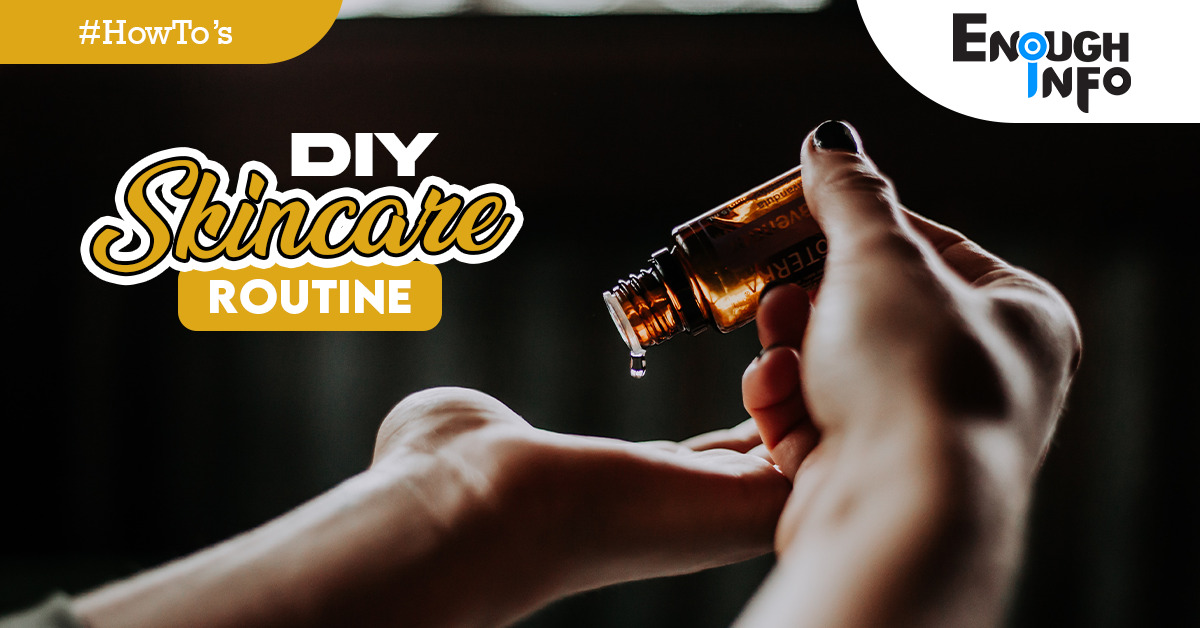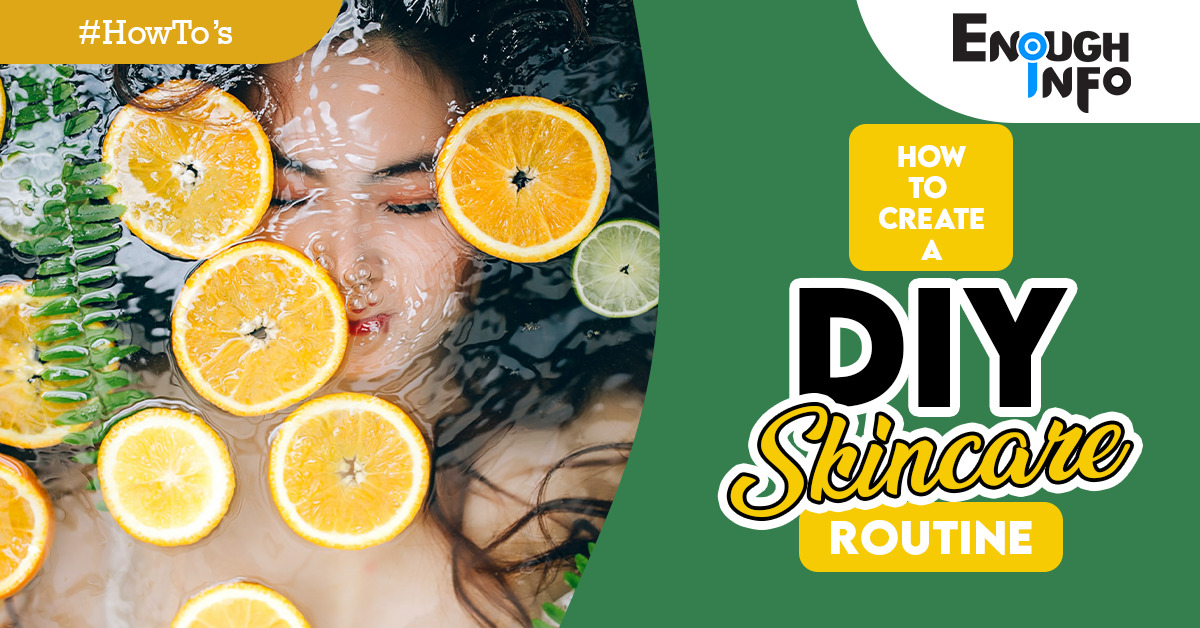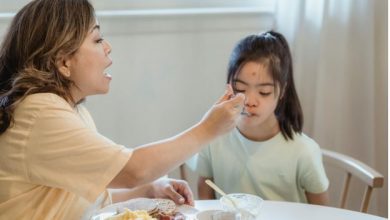How To Create a DIY Skincare Routine

How To Create a DIY Skincare Routine: Taking care of your skin is essential for maintaining its health, radiance, and overall well-being. While there are numerous skincare products available on the market, creating a DIY skincare routine allows you to personalize your regimen according to your unique skin type and concerns. EnoughInfo.com

Having good skin-care products isn’t enough: You must also apply your items in the precise order for them to be effective. Your routine will be determined by your skin type, product components and formulations, and time of day. However, a good rule of thumb is to apply in order of texture, from thinnest to thickest, because thin items will not penetrate heavier ones.
Whatever your skin concerns, start with a clean, toned base, then apply concentrated, active products, and end by sealing in moisture—and, of course, SPF during the day. How to Clean Stainless Steel Appliances
Read Also: 11 Benefits of Organic Skincare for Sensitive Skin
FAQs & Answers on How To Create a DIY Skincare Routine
1. Can I use DIY skincare products if I have sensitive skin?
Yes, you can use DIY skincare products even if you have sensitive skin. However, it’s important to be cautious and perform patch tests before applying any new ingredients or products to your face. Start by testing a small amount of the DIY product on a small area of your skin, such as the inner forearm, and observe for any adverse reactions for at least 24 hours. If you experience redness, itching, or irritation, avoid using that particular ingredient or product. How Much To Tip On A Cruise (7 Cruise Tipping Guidelines)
2. How long should I wait to see results from my DIY skincare routine?
Results from a skincare routine can vary depending on individual factors, such as skin type, concerns, and the specific products used. Generally, it may take several weeks or even a couple of months to notice significant improvements in your skin’s condition. Consistency is key, so stick to your DIY skincare routine and give it time to work. If you have specific concerns, such as acne or hyperpigmentation, it’s advisable to consult a dermatologist for personalized advice.
3. Can I combine DIY skincare with store-bought products?
Absolutely! You can integrate DIY skincare products with store-bought products to customize your skincare routine further. For example, you can incorporate a DIY face mask into your weekly routine while using a store-bought cleanser, moisturizer, or sunscreen. The key is to select products that complement each other and address your specific skincare needs.
4. Are DIY skincare products as effective as commercial products?
DIY skincare products can be effective, but it depends on the ingredients used, their concentrations, and your skin’s individual response. Commercial products are often formulated with specific technologies and backed by extensive research and testing. However, DIY skincare allows you to have more control over the ingredients you use and tailor your routine to your skin’s needs. It’s important to research ingredients, follow proper guidelines, and monitor your skin’s reaction to ensure effectiveness and safety.
5. How often should I adjust my DIY skincare routine?
A5: It’s advisable to reassess and adjust your skincare routine periodically, especially if you notice changes in your skin’s condition or have specific concerns. Factors such as weather, age, hormonal fluctuations, and lifestyle changes can influence your skin’s needs. Regularly evaluate your routine and make adjustments accordingly, whether it’s swapping out certain ingredients, increasing or decreasing exfoliation frequency, or incorporating new products to target specific concerns.
Read Also: How To Create A DIY Home Decor
Important Reasons for Understanding How to Create a DIY skincare routine:
1. Personalization:
DIY skincare allows you to tailor your routine to meet your specific skin type, concerns, and preferences. Everyone’s skin is unique, and by creating your own skincare products, you can choose ingredients that work best for you, avoiding potential irritants or allergens found in commercial products. How To Play the Guitar For Kids
2. Control over Ingredients:
Commercial skincare products often contain a long list of ingredients, some of which may be synthetic or potentially harmful. With a DIY skincare routine, you have full control over the ingredients you use. You can opt for natural, organic, or locally sourced ingredients, ensuring that you’re nourishing your skin with the best possible choices.
3. Cost-Effectiveness:
DIY skincare can be more cost-effective in the long run compared to buying expensive commercial products. Many effective skincare ingredients can be found in your kitchen pantry or easily sourced from local stores. By creating your own products, you can save money without compromising on quality.
4. Transparency and Sustainability:
DIY skincare allows you to have transparency in what you’re putting on your skin. You know exactly what ingredients are included and their respective benefits. Additionally, it promotes sustainability by reducing reliance on single-use plastic packaging and minimizing environmental impact.
Read Also: How to Get Spray Paint off Skin
5. Empowerment and Education:
Learning how to create a DIY skincare routine empowers you to take charge of your own skincare journey. It encourages self-education about different skincare ingredients, their properties, and how they can benefit your skin. This knowledge enables you to make informed decisions and adapt your routine as needed.
Experimentation and Customization: DIY skincare routines provide the flexibility to experiment with different ingredients and formulations. You can try various recipes and adjust them based on your skin’s response. This allows you to continually refine and improve your routine to achieve optimal results.
Holistic Approach: Creating a DIY skincare routine promotes a holistic approach to skincare. It encourages self-care rituals, mindfulness, and a deeper connection with your skin. By taking the time to create and apply your own products, you cultivate a sense of self-nurturing and prioritize your well-being. How To Clean Hardwood Floors Naturally
Creative Outlet: DIY skincare offers a creative outlet where you can express your personality and preferences. You can experiment with scents, textures, and combinations of ingredients to create products that are not only effective but also enjoyable to use.
Education for Others: Sharing your DIY skincare knowledge and recipes with friends and family can inspire and educate others. By demonstrating the benefits of natural skincare and the potential to create effective products at home, you can empower others to take control of their skincare routines and make healthier choices.
Sustainable Lifestyle: Incorporating a DIY skincare routine into your lifestyle aligns with a broader movement toward sustainability and conscious living. By reducing your reliance on commercial products and embracing natural alternatives, you contribute to a more sustainable and environmentally friendly approach to skincare.
Learning how to create a DIY skincare routine is important because it allows for personalization, control over ingredients, cost-effectiveness, transparency, empowerment, experimentation, and a holistic approach to skincare. It enables you to make conscious choices for your skin’s health while promoting sustainability and self-care. Embrace the journey of creating your own skincare products and enjoy the benefits of a personalized and nurturing skincare routine.
Read Also: How to Treat a Yeast Infection on Your Skin
The Ultimate Guide to Creating Your DIY Skincare Routine: Achieve Radiant and Healthy Skin

In this comprehensive guide, we will explore step-by-step instructions for creating a DIY skincare routine, along with answers to frequently asked questions to help you achieve the glowing complexion you desire.
Understanding Your Skin:
Before diving into the specifics of a DIY skincare routine, it’s crucial to understand your skin type and its specific needs. The four common skin types are:
- Normal: Balanced skin with few imperfections and a generally even complexion.
- Dry: Lacks moisture and tends to be flaky or rough. How To Make A DIY Gift For A Friend
- Oily: Produces excess sebum, leading to a shiny appearance and potential acne breakouts.
- Combination: A mix of both oily and dry areas, with the T-zone (forehead, nose, and chin) being oilier.
Identifying your skin type will help you select the appropriate ingredients and products for your DIY skincare routine.
Creating Your DIY Skincare Routine:
-
Cleansing:
Start your skincare routine with a gentle cleanser suited to your skin type. Cleansing removes dirt, impurities, and excess oil, preparing your skin for subsequent steps. Choose cleansers that are free of harsh chemicals and fragrance.
-
Exfoliation:
Exfoliation helps remove dead skin cells, unclogs pores, and promotes skin cell turnover. Use a gentle exfoliator once or twice a week, depending on your skin’s sensitivity. Opt for natural exfoliants like sugar, coffee grounds, or finely ground oats.
-
Toning:
Toning helps balance your skin’s pH levels and minimizes the appearance of pores. Use a toner suitable for your skin type, such as rose water or witch hazel. Apply it with a cotton pad or spritz it onto your face for a refreshing effect.
-
Hydration:
Moisturizing is crucial for all skin types, even oily skin. Choose a moisturizer that provides hydration without clogging pores. Look for ingredients like hyaluronic acid, glycerin, or aloe vera. Apply the moisturizer evenly to your face and neck, focusing on areas prone to dryness. How To Play The Piano Without Reading Sheet Music
-
Sun Protection:
Protecting your skin from harmful UV rays is essential to prevent premature aging and reduce the risk of skin cancer. Apply a broad-spectrum sunscreen with an SPF of 30 or higher as the final step in your morning skincare routine.
DIY Skincare Ingredients:
When creating a DIY skincare routine, it’s important to choose ingredients that are beneficial for your skin type and concerns. Here are some commonly used ingredients and their benefits:
- Honey: A natural humectant that moisturizes and soothes the skin.
- Coconut Oil: A hydrating and antimicrobial oil that can be used as a moisturizer or makeup remover.
- Green Tea: Packed with antioxidants that protect the skin from damage and soothe inflammation.
- Aloe Vera: Known for its soothing properties and ability to heal sunburns, acne, and inflammation.
- Jojoba Oil: A lightweight oil that closely resembles the skin’s natural sebum, making it suitable for all skin types.
- Tea Tree Oil: Has antibacterial properties and can be used to treat acne and skin infections.
- Rosehip Seed Oil: Rich in vitamins A and C, it helps brighten the skin and reduce the appearance of scars and fine lines.
Read Also: How To Look Fresh (The Ultimate Guide)
Conclusion
Creating a DIY skincare routine allows you to personalize your skincare regimen according to your unique needs, preferences, and skin type. Understanding your skin type, following the basic steps of cleansing, exfoliating, toning, moisturizing, and protecting from the sun, and incorporating beneficial DIY ingredients can help you achieve healthy and radiant skin. However, it’s important to remember that skincare is not a one-size-fits-all approach, and what works for one person may not work for another. Listen to your skin, be consistent, and don’t hesitate to seek professional advice when needed. With patience, dedication, and the right knowledge, you can create a DIY skincare routine that promotes the health and beauty of your skin.
Recommended;
How To Be A Clean Person (10 Great Ways)
23 Best Ways To Remove Blackheads(All You Need Know)




